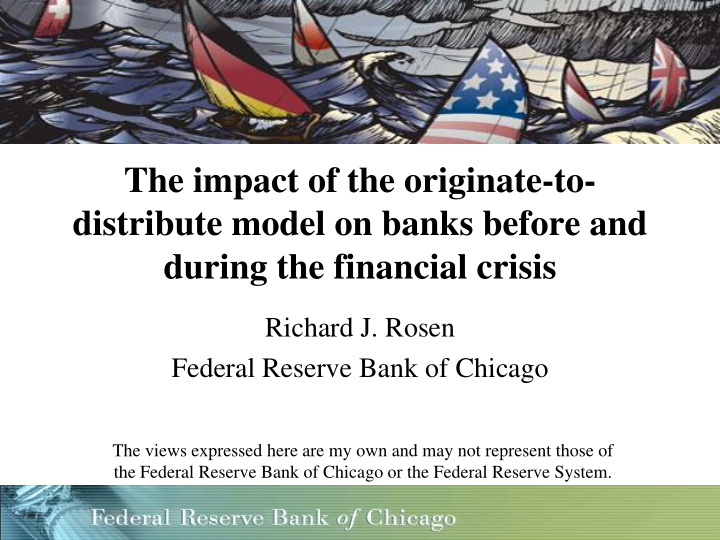



The impact of the originate-to- distribute model on banks before and during the financial crisis Richard J. Rosen Federal Reserve Bank of Chicago The views expressed here are my own and may not represent those of the Federal Reserve Bank of Chicago or the Federal Reserve System.
Mortgage sales and the OTD model I examine the role of mortgage sales by banks. • Banks often sell the mortgages they originate, but only 5-10 commercial banks issue bonds backed by mortgages (that is, securitize mortgages). I focus on mortgage sales by the originating bank. Banks may sell loans as a separate business. • The originate-to-distribute (OTD) model is where banks originate loans never intending to hold them in portfolio. The objective is to sell the loans and earn fee income. • The OTD model is made easier by securitization, but banks that sell loans need not be ‘securitizers.’
Loan sales vs. securitization Bank securitizes its own loans Bank Bank loan Bank-run MBS bond Borrower office Loan MBS pool Bond holders Loan sale sale Bank sells loans which others GSE or financial securitize firm MBS bond MBS pool Borrower Bank Loan Bond holders Loan sale sale Loan Loan sale sale Alternative Financial path for loan firm
Data To test the use and impact of mortgage sales I use: • Info on mortgage sales: HMDA • Balance sheet data: Call Reports • Stock market data: CRSP I initially focus on banks in the 1996-2006 period before the start of the financial crisis. • The sample is limited to banks with some mortgage activity. • Banks also must have traded stock (so most small banks are not in the sample). The final sample has 460 banks (using parent level for banks; unbalanced panel).
Key mortgage flow data Measure of mortgage sales: • SOLD = mortgages sold / total assets of the bank Mean Median 2.42 0.11 Sold mortgages ($ billions) 0.12 0.04 SOLD (sold mortgages/TA) 0.45 0.47 Share of mortgages that are sold
Purchase vs. refinancing
Data on mortgages (Table 1): mortgage flow / total assets TA PURCH REFI STK RET SOLD PORT Ranked by SOLD SOLD NET ($ bil) SOLD: Below 1.99% 0.82% 1.17% 3.62% 29.90 2.26% median Median-75 th 6.76% 2.86% 3.90% 3.72% 39.80 3.72% pctile 75-90 th pctile 14.48% 6.30% 8.18% 4.57% 13.60 3.71% 90-100 th 67.75% 32.34% 35.45% 5.77% 29.80 5.95% pctile Sample mean 11.71% 5.34% 6.38% 4.01% 28.60 3.22%
Effect of mortgage flow on bank portfolios (Tables 3-4) An increase in mortgage sales (SOLD) leads to: • A minimal increases in residential loans on balance sheet, consistent with a pipeline effect. • No significant impact on future non-performing loans. • Little impact on non-mortgage assets (except MBS, which fall). An increase in mortgages issued and held in portfolio (PORT) leads to: • An increase in residential loans on balance sheet. • A reduction in non-mortgage asset portfolio shares as expected, with the reductions not concentrated in any one asset class.
Effect of mortgage sales on profit (Table 5) (1) (2) VARIABLES STK RET STK RET SOLD 0.217*** -0.291 PORT PURCH SOLD -0.054 REFI SOLD 0.279*** -0.379 PURCH PORT 0.207 REFI PORT SECUR 0.287 0.290
Effect of mortgage sales on profit Sold mortgages increase profit, but this increase is due to refis. • Do some banks use refi booms to increase market share? If so, market share gains should be mostly temporary.
Are increases in refi mortgage sales permanent? (Table 7) REFI SOLD PURCH SOLD REFI PORT PURCH PORT 1-year 0.837 0.907 0.760 0.885 persistence 2-year 0.573 0.855 0.591 0.775 persistence 3-year -0.365 0.755 0.466 0.924 persistence 4-year -0.160 0.960 0.480 0.968 persistence
Do loans in refi booms look different from loans in other periods? (Table 8) (1) (2) (3) (4) VARIABLES REFI REFI PURCH PURCH AMT/INC AMT/INC AMT/INC AMT/INC REFI BOOM 0.123 -0.000 REFI BOOM 0.383*** 0.133 TOP 10 REFI BOOM 0.098 -0.013 BOT 90
The financial crisis, the OTD model, and bank profit: What goes up must come down? I examine stock returns for the crisis (2007-2008) and compare them to stock returns for the pre-crisis period (2001-2006). Crisis could reduce equity value of OTD banks because: • Loss of new business • Pipeline loan losses • Clawbacks
Changes in profit as a function of mortgages sales ranked over 2001-2006 (Table 9B) 2007-2008 stock return 2001-2006 stock return 90 th – 100 th 90 th – 100 th 0-90 th pct 0-90 th pct pct pct -0.10% PURCH SOLD -0.47% -10.51% -39.60% -29.43% REFI SOLD -1.07% 8.21% 64.50% -46.72% Memo: Stock return -22.97%
Conclusions • The impact of mortgage sales on banks are consistent with the OTD model. • The OTD model is easily scalable, and the evidence is consistent with some banks temporarily scaling up for refi booms. • The increase in profit for banks from mortgage sales during the pre- crisis period was largely offset by losses during the crisis. • Gains and losses associated with mortgage sales were small for most banks (in absolute size and relative to overall gains and losses), but not for the banks most concentrated in mortgage sales.
Recommend
More recommend